42 reading sodium on food labels
We've been reading nutrition labels WRONG all this time 'Carbohydrates in the nutrition label includes starches and sugars. Foods with high amounts of starches are white, wholemeal and wholegrain varieties of breads, cereal, rice and pasta, root ... How to Decode Salt on Food Labels: Low Sodium vs Reduced Sodium vs ... "Low sodium," "very low sodium," and "salt- or sodium-free" on food labels translate to less than 140, 35, and 5mg per serving, respectively. These front-of-the-package claims can help you spot legit lighter-sodium products at the supermarket—look for low sodium chicken broth, low sodium canned beans, low sodium bread, and low sodium soy sauce.
How To Read Food and Beverage Labels - National Institute on … Most older adults exceed the recommended limits for saturated fats, sodium, and added sugars. Compare and choose foods to get less than 100% DV of these each day, making sure to adjust for how many calories are in your diet. Additionally, many older adults do not get the recommended amounts of dietary fiber, vitamin D, calcium, and potassium.
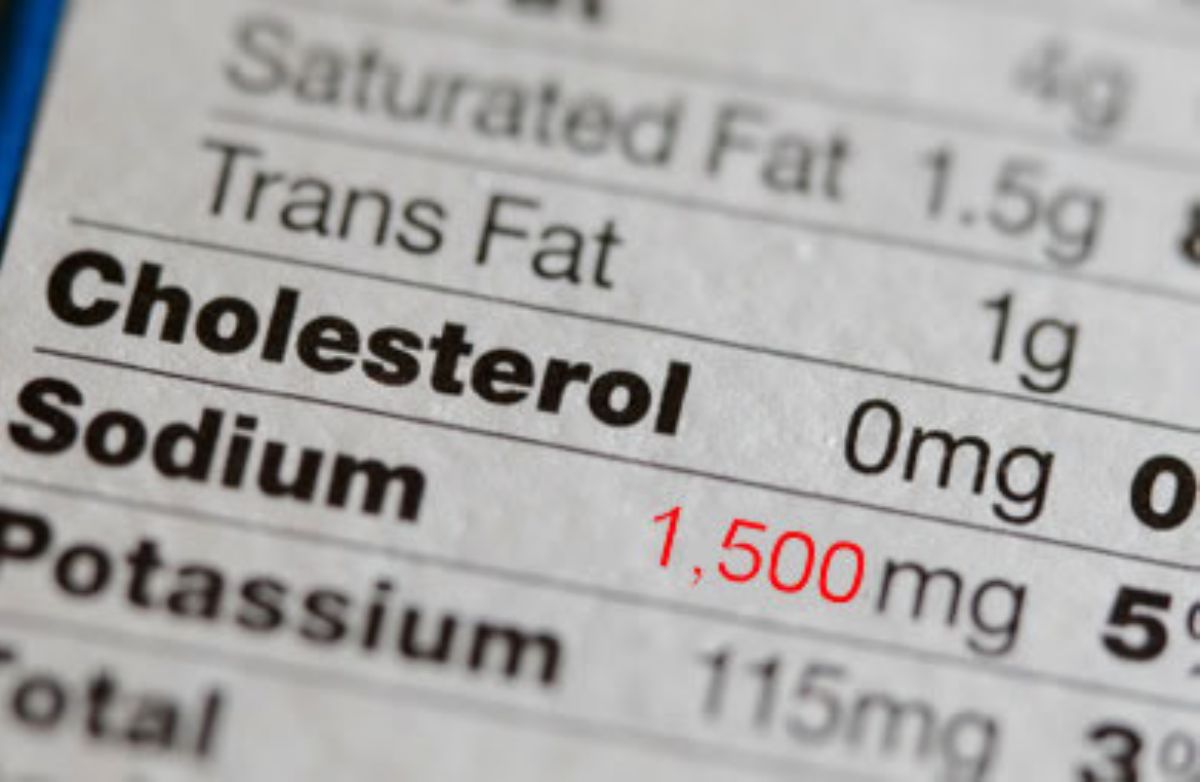
Reading sodium on food labels
PDF Read the Nutrition Facts Label for Sodium! - National Institutes of Health Sodium 125mg 5% Total Carbohydrate 9g 3% Dietary Fiber 3g 12% Sugars 4g Protein 2g Vitamin A 35% • Vitamin C 6% Calcium 2% • Iron 2% Read the Nutrition Facts Label for Sodium! Nutrition Facts labels tell you what you need to know about choosing foods that are lower in sodium. Here is a Nutrition Facts label for frozen peas and carrots ... How to Read a Food Label to Limit Sodium: Care Instructions On most foods, there is a Nutrition Facts label. This will tell you how much sodium is in one serving of food. Look at both the serving size and the sodium amount. The serving size is located at the top of the label, usually right under the "Nutrition Facts" title. The amount of sodium is given in the list under the title. How to Read Sodium Percentages on Food Packages A "very low sodium" product must have less than 35 milligrams of sodium, while a "low sodium" product must have less than 140 milligrams of sodium. All in the Name Along with reading the food...
Reading sodium on food labels. Sodium: How to Read Food Labels - Intermountain Healthcare NUTRITION INFORMATION FROM YOUR DIETITIAN ... Reading food labels can help you monitor how much sodium you are getting in your diet. Here are some of. how to understandfood labels | Eat For Health Less than 3g per 100g is best. Sodium (Salt). Choose lower sodium options among similar foods. Food with less than 400mg per. Sodium & Your Heart Health: How To Read Nutrition Facts On Food Labels Food can be considered low-sodium if the total sodium content is 140mg or less and is based on serving size. Overindulging on the portions with a low-sodium food can potentially be just as detrimental as eating a food that's high in salt. Additionally, people shopping for low-sodium foods should opt for packaging that features a 5% DV or lower. What Sodium Labels Mean: A Guide to Decoding ... - The Kitchn On the back of a product, you'll find the nutrition label which will list the percentage daily value (or %DV) of sodium found in one serving. Be aware that the %DV is based on the upper recommended limit of daily sodium, or 2,400mg. Remember to Check the Serving Size
How to Read a Food Label to Limit Sodium: Care Instructions This will tell you how much sodium is in one serving of food. Look at both the serving size and the sodium amount. The serving size is located at the top of the ... Sodium and Food Labels | Sutter Health It's important to note that all nutritional labels list amounts of nutrients per serving. This item, for example, lists 16 servings in the entire container. The sodium level is 120 mg for one serving. That means if you drink the entire container, you'll get 1,920 mg sodium! That could be a critical error if you're not careful. Reading Food Labels - What You Need to Know - Drugs.com "Low sodium": One-hundred forty (140) mg or less per serving. "Very low sodium": Thirty-five (35) mg or less per serving. "Reduced" or "less" sodium: At least 25 percent less sodium per serving. Health Claims: Food labels may have a message that tells how a food or part of a food affects a disease or a health condition. The United States Food ... How to Understand and Use the Nutrition Facts Label | FDA - U.S. Food ... Nutrients to get less of: Saturated Fat, Sodium, and Added Sugars. Saturated fat, sodium, and added sugars are nutrients listed on the label that may be associated with adverse health effects - and...
Understanding Food Labels | The Nutrition Source | Harvard T.H. The FDA has approved 12 health claims on food labels such as the relationship between calcium and osteoporosis; sodium and hypertension; fiber-containing grains, fruits and vegetables and cancer; and folic acid and neural tube defects. However, just because a food contains a specific nutrient that is associated with a decreased risk of disease does not necessarily make the food … 6 Free Printable Food Labels Worksheet & Different Types Reading food labels is an exercise in making decisions and balancing priorities. The purpose of this reading food labels worksheet is to help you become familiar with the different content listed on food labels and the corresponding regulations. Tips for creating a food labels worksheet. Some specific rules and laws need to be followed on a food labels worksheet. A food labels … Understanding Food Nutrition Labels | American Heart Association If you want to consume less of a nutrient (such as saturated fat or sodium), choose foods with a lower % DV (5 percent or less). If you want to consume more of a nutrient (such as fiber), choose foods with a higher % DV (20 percent or more). Here are more tips for getting as much health information as possible from the Nutrition Facts label: How to Read Food Labels | mySugr Look at the total grams of carbs and calories listed on the food label, too. Don't Forget Sodium Sodium, or salt, doesn't affect blood sugar. But, eating too much salt increases your risk of heart disease and high blood pressure. Some foods don't taste salty, but contain hidden salts. Reading labels makes it easier to find hidden sources of sodium.
How to Read Salt Labels | Cooking Light When food companies make sodium claims, they have to follow labeling rules. For the consumer, the tricky part is that there are four claims. Two apply when a company is comparing their food to a loosely defined fully salted version. One refers to a specific sodium level, another to whether salt has been added.
How to Read a Food Label to Limit Sodium: Care Instructions - Alberta The label lists the ingredients in a food in descending order (from the most to the least). If salt or sodium is high on the list, there may be a lot of sodium in the food. Know that sodium has different names. Sodium is also called monosodium glutamate (MSG), sodium citrate, sodium alginate, and sodium phosphate. Read Nutrition Facts tables
Understanding food labels - Canada.ca Food labels, nutrition facts tables, serving size, ingredients, % daily value, nutrition claims. Services and information. Nutrition facts tables . How to use, what is in them, foods that don't have a nutrition facts table. Serving size. How to use the serving size on nutrition facts tables. List of ingredients. About list of ingredients on packaged foods, common terms used for some ...
Label reading 101 - Healthy Food Guide Label reading cheat sheet For any packaged food product you choose, the health guidelines to aim for are: Less than 10g fat per 100g Less than 15g sugar per 100g Less than 120mg sodium per 100g What about the Health Star Rating? This Australian government health initiative ranks products on a scale from half a star to five stars.
Sodium on the Nutrition Facts Label | FDA - U.S. Food and Drug ... Most Americans eat too much sodium and diets higher in sodium are associated with an increased risk of developing high blood pressure. The Nutrition Facts label is a handy tool you can use every...
Reading food labels: Tips if you have diabetes - Mayo Clinic Put sugar-free products in their place. Sugar-free doesn't mean carbohydrate-free. Sugar-free foods may play a role in your diabetes diet, but remember that it's equally important to consider carbohydrates as well. A sugar-free label means that one serving has less than 0.5 grams of sugar. When you're choosing between standard products and ...
Is Sodium the Same Thing as Salt? - Academy of Nutrition and … 08/08/2019 · On the label, look for foods that are lower in sodium. Choose foods with less than 120 milligrams of sodium per serving. Look for the words salt-free, sodium-free, very low sodium and low sodium on the label. Double-check sodium content of foods with labels that read unsalted, no salt added, reduced sodium or lower sodium. These items may still ...
How do you read a food label for salt / sodium? Sodium x 2.5 = salt content or Salt ÷ 2.5 = sodium content. If you have kidney disease a good goal for sodium intake is 2300 mg of sodium or 6g salt per day. Check with your Doctor or Kidney (Renal) Dietitian to confirm what your maximum daily salt (sodium) limit should be. Nutrition information may be presented in two ways.
how to understand food labels - Eat For Health Sodium (Salt) Choose lower sodium options among similar foods. Food with less than 400mg per 100g are good, and less than 120mg per 100g is best. Ingredients Listed from greatest to smallest by weight. Use this to check the first three ingredients for items high in saturated fat, sodium (salt) or added sugar. Other names for ingredients high in
Food Labels: Read It Before You Eat It! - American Academy of Allergy ... For example, sodium caseinate can be used to indicate that a product contains a milk protein called casein. Therefore, when reading a food label, start with the "contains" statement.
Making Sense of Food Labels | ADA - American Diabetes … Reading Food Labels Making Sense of Food Labels. Trying to figure out nutritional information on labels and packaging isn’t easy. The good news is that we can help. These food labels are especially helpful if you use carb counting to plan your meals! If you get tripped up on food content claims, you’re not alone. Fat free vs. low fat vs. reduced fat. Low cholesterol vs. …
How to Read Labels for a Low Sodium Diet - Salt Sanity Sodium nitrate is used to cure meats so you'll likely find it on labels of foods like lunch meat, bacon, and hot dogs. Research indicates sodium nitrate can damage arteries, causing them to harden and narrow, a potentially dangerous situation for patients with heart disease. There are some high sodium ingredients you will recognize.

Healthy eating habits/Reading Food Labels to Make Healthy Food Choices - Wikibooks, open books ...
Sodium: How to Read Food Labels - Intermountain Healthcare 660 milligrams of sodium per serving — your actual percentage of sodium would be 33%, slightly higher than listed. Sodium is listed in milligrams. A food low in sodium should have about 140 milligrams or less per serving. The ingredients list will show you every ingredient in the product. The higher an ingredient appears on the list,
Reading Labels - World Action on Salt & Health Some food labels may only state the sodium content. To convert sodium to salt, you need to multiply the amount by 2.5. For example, 1g of sodium per 100g = 2.5 grams of salt per 100g. You then need to know the weight of the serving portion in grams e.g. 30g. Then divide the concentration of salt per 100g by 100 and multiply by the serving size.
PDF Reading Food Labels to Look for Sodium - ksw-gtg.com Easy-to-read food labels can help you find foods low in sodium. This will help you keep track of the number of grams (g) or milligrams (mg) you consume each day. According to Food and Drug Administration regula- tions, no manufacturer can say that their product is "low-sodium" unless they can prove that claim.
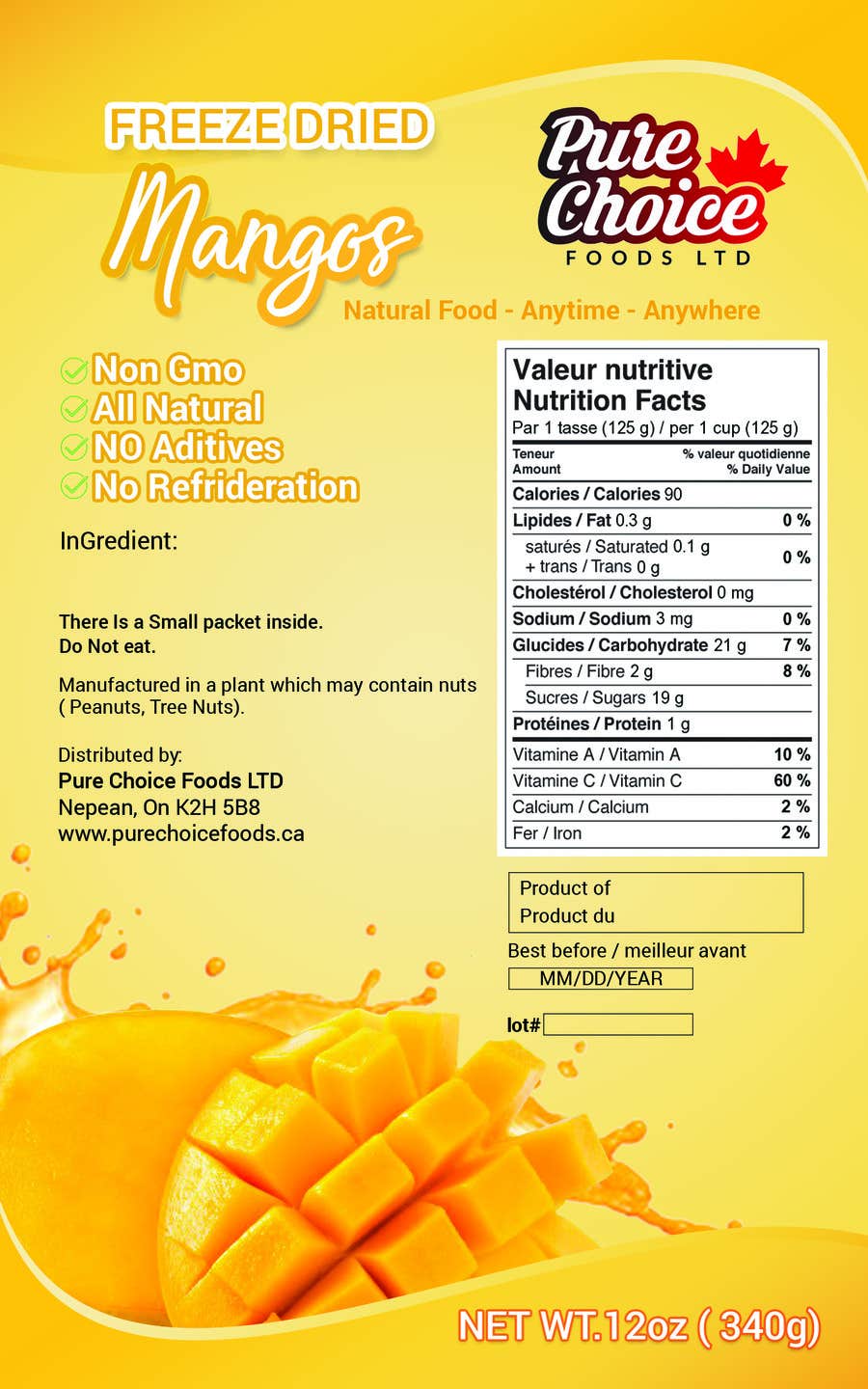




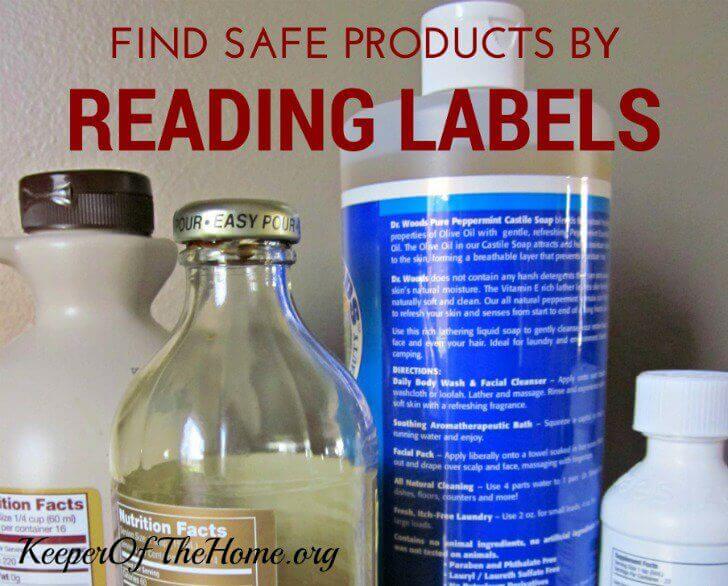
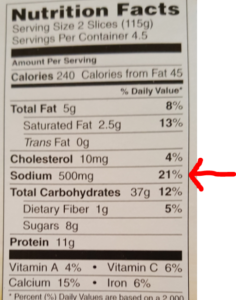

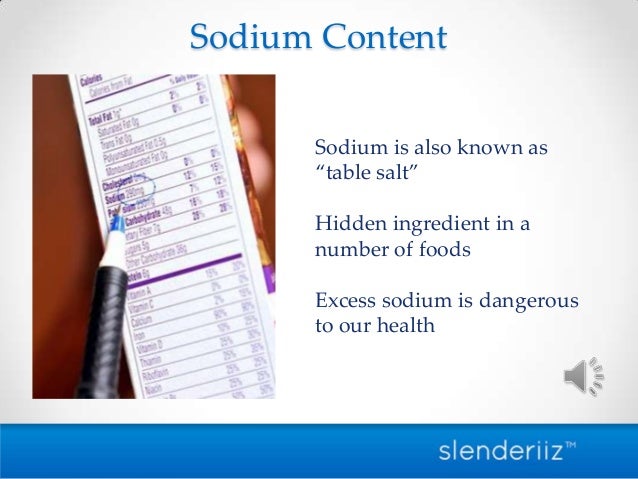

Post a Comment for "42 reading sodium on food labels"